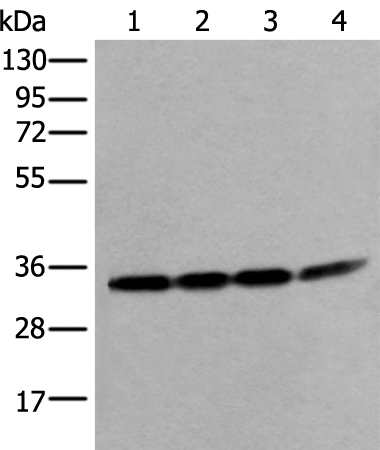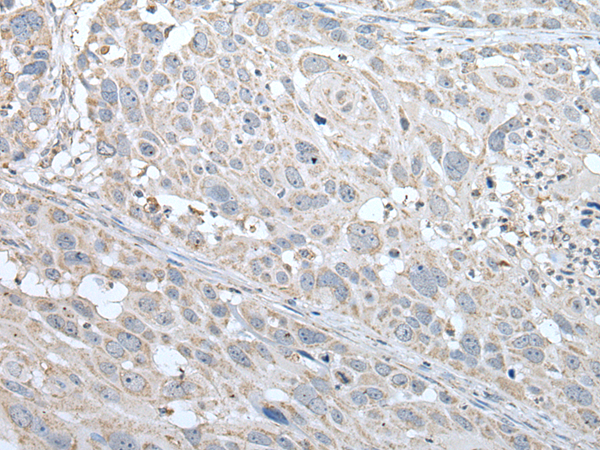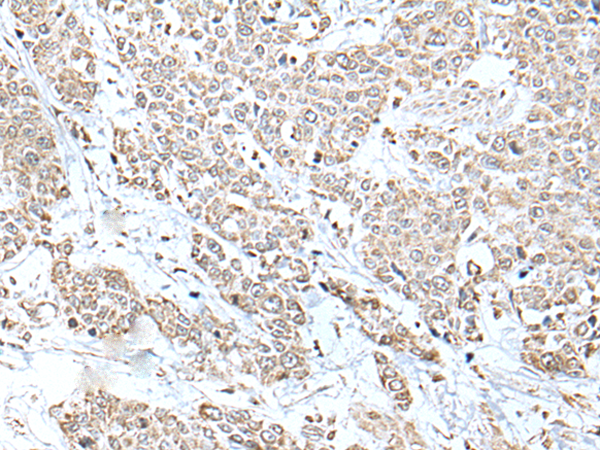


| WB | 咨询技术 | Human,Mouse,Rat |
| IF | 咨询技术 | Human,Mouse,Rat |
| IHC | 1/25-1/100 | Human,Mouse,Rat |
| ICC | 技术咨询 | Human,Mouse,Rat |
| FCM | 咨询技术 | Human,Mouse,Rat |
| Elisa | 1/5000-1/10000 | Human,Mouse,Rat |
| Aliases | PORIN; VDAC-1 |
| WB Predicted band size | 31 kDa |
| Host/Isotype | Rabbit IgG |
| Antibody Type | Primary antibody |
| Storage | Store at 4°C short term. Aliquot and store at -20°C long term. Avoid freeze/thaw cycles. |
| Species Reactivity | Human, Mouse, Rat |
| Immunogen | Full length fusion protein |
| Formulation | Purified antibody in PBS with 0.05% sodium azide and 50% glycerol. |
+ +
以下是关于VDAC1抗体的3篇参考文献及其简要摘要:
1. **"Voltage-dependent anion channels (VDACs) as critical regulators of cell survival: A focus on VDAC1 in cancer"**
*作者:Shoshan-Barmatz V, et al.*
**摘要**:探讨了VDAC1在癌细胞凋亡中的核心作用,研究中使用特异性抗体验证VDAC1的表达水平及与凋亡相关蛋白的相互作用,揭示了其在调控线粒体膜通透性中的功能。
2. **"Antibody-based profiling of VDAC1 isoforms and post-translational modifications in neurodegenerative disease models"**
*作者:Mannella CA, et al.*
**摘要**:通过Western blot和免疫荧光技术,利用VDAC1特异性抗体分析其在阿尔茨海默病模型中的亚型分布及磷酸化修饰,发现VDAC1异常修饰与线粒体功能障碍相关。
3. **"VDAC1 antibody inhibits oligomerization and ameliorates neurotoxicity in Parkinson's disease"**
*作者:Guo L, et al.*
**摘要**:研究开发了一种阻断VDAC1寡聚化的抗体,实验表明该抗体可减少α-突触核蛋白介导的线粒体损伤,为帕金森病治疗提供了潜在靶点。
以上文献均涉及VDAC1抗体的应用,涵盖癌症、神经退行性疾病中的功能机制及治疗潜力。
The voltage-dependent anion channel 1 (VDAC1) antibody is a crucial tool for studying the function and regulation of VDAC1. a protein predominantly located in the outer mitochondrial membrane. VDAC1. also known as mitochondrial porin, forms a channel that regulates the passage of metabolites, ions, and nucleotides between the mitochondria and cytoplasm, playing a central role in energy metabolism, calcium signaling, and apoptosis. It interacts with proteins involved in mitochondrial dynamics, such as Bcl-2 family members and hexokinase, and is implicated in modulating mitochondrial permeability transition pore (mPTP) opening, a key event in programmed cell death.
VDAC1 antibodies are widely used in techniques like Western blotting, immunofluorescence, and immunoprecipitation to detect protein expression levels, subcellular localization, and protein-protein interactions. These antibodies help investigate VDAC1’s role in diseases, including cancer (e.g., metabolic reprogramming in tumors), neurodegenerative disorders (e.g., impaired mitochondrial function in Alzheimer’s or Parkinson’s), and cardiovascular conditions (e.g., ischemia-reperfusion injury). Additionally, they aid in exploring post-translational modifications (e.g., phosphorylation, acetylation) that regulate VDAC1 activity under stress or pathological conditions.
High specificity and validation are critical for VDAC1 antibodies due to homology among VDAC isoforms (VDAC1-3) and potential cross-reactivity. Researchers rely on these antibodies to dissect mitochondrial dysfunction mechanisms and evaluate therapeutic strategies targeting VDAC1 in disease models.
×